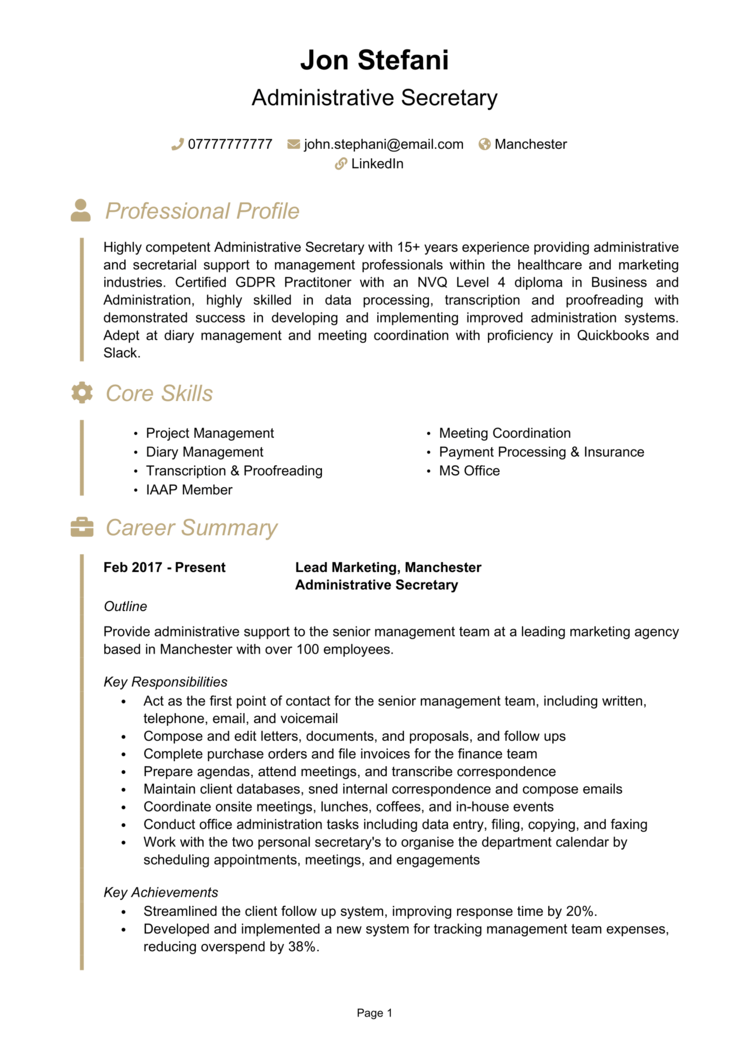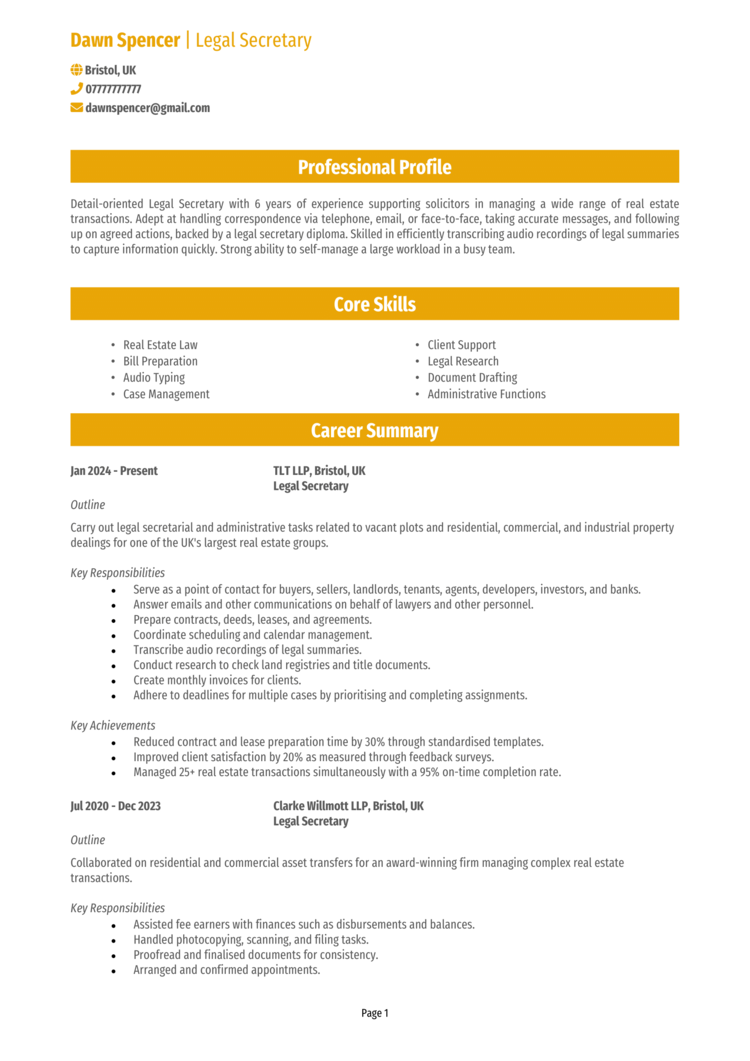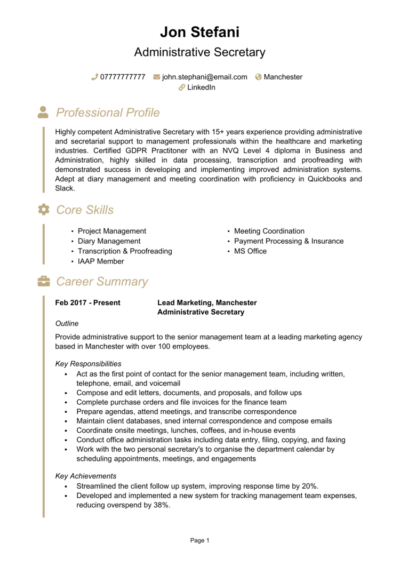Got a knack for making chaos disappear with a single spreadsheet? Countless businesses rely on secretaries to run smoothly, so there are plenty of opportunities for this rewarding role.
This guide, complete with 4 Secretary CV examples, will help you craft an application that puts you at the top of the pile.
Secretary CV example

Company Secretary CV example

Legal Secretary CV example

Medical Secretary CV example

How to write your Secretary CV
Learn how to create your own interview-winning Secretary CV with this simple step-by-step guide.
This guide will walk you through writing a Secretary CV that highlights your organisational skills, administrative expertise, and ability to multitask. By the end, you’ll have a CV that opens doors to your next opportunity.
The best way to structure your Secretary CV


If your CV is as organised as your filing cabinets, a recruiter will easily be able to navigate the things that make you the ideal candidate for the position.
Here’s how to structure your Secretary CV’s layout:
- Name and contact details – Place these at the top for immediate reference. A photo is also an optional addition.
- CV profile – Provide a summary of your administrative expertise, efficiency, and achievements.
- Core skills – Highlight strengths like diary management and document preparation.
- Work experience – Detail your roles in reverse chronological order, focusing on responsibilities and accomplishments.
- Education – Include academic qualifications and certifications relevant to secretarial or administrative work.
- Additional info – Optionally, mention relevant interests, or skills such as language proficiency or professional memberships.
Secretary CV format


Your CV format should reflect the professionalism and attention to detail you bring to your role as a Secretary. Poor formatting can overshadow even the most impressive skills, so keep it clean and polished.
Here’s some tips to format your Secretary CV effectively:
- Bullet points – Break information into snappy, impactful points that are easy to skim through.
- Divide sections – Structure your CV with distinct sections that make it easy to scan.
- Use a clean font – Stick to professional, readable fonts with consistent formatting.
- Keep it the right length – It’s important to balance brevity with detail. Keep it no more than 2 pages to ensure your CV remains engaging while covering all relevant details.
How to write a Secretary CV profile


Your CV profile is your opportunity to highlight your administrative expertise and show why you’re the ideal secretary for the role. This is where you summarise your experience, top qualifications, and most marketable skills.
Secretary CV profile examples
Profile 1
Organised Secretary with five years of experience in the legal sector, adept at managing schedules, drafting correspondence, and maintaining client confidentiality. Proficient in Microsoft Office and case management software, ensuring seamless office operations.
Profile 2
Reliable Secretary with three years in the healthcare industry, skilled in coordinating meetings, preparing reports, and handling sensitive information. Experienced in using scheduling software and electronic record systems to support efficient day-to-day functions.
Profile 3
Dedicated Secretary with over eight years of experience in corporate environments, focusing on executive support and office management. Skilled in calendar management, travel coordination, and preparing detailed meeting minutes. Proficient in SAP and Google Workspace for streamlined administrative tasks.
What to include in your Secretary CV profile
Tailor your profile to the role by emphasising key skills and experiences that match the job description.
Here’s what to include in your Secretary CV profile:
- Where you’ve worked – Mention industries or organisations where you’ve provided secretarial support, such as law firms, schools, or corporate offices.
- Your top qualifications – Highlight credentials like a diploma in administration or certifications in office software.
- Essential skills – Include diary management, correspondence handling, and minute-taking.
- People you’ve supported – Reference the types of professionals you’ve worked with, such as executives, managers, or entire teams.
- Tools you’ve mastered – Mention proficiency in office software, scheduling platforms, or document management systems.
Core skills section


The core skills section is your chance to highlight the abilities that make you a standout Secretary. Think of it as a quick reference guide that gives recruiters an instant understanding of what you bring to the role.
For secretarial roles, focus on organisational and interpersonal skills that demonstrate your ability to manage administrative tasks efficiently.
Above all else, tailor these skills to the specific role and industry you’re applying for.
Top skills for your Secretary CV
- Diary Management – Coordinating schedules and organising meetings to optimise time management.
- Correspondence Handling – Managing emails, letters, and phone calls professionally and promptly.
- Minute-Taking – Accurately recording and distributing meeting notes for future reference.
- Document Preparation – Creating and formatting reports, presentations, and spreadsheets to a professional standard.
- Event Coordination – Organising conferences, travel arrangements, and team-building activities.
- Filing and Record-Keeping – Maintaining organised and up-to-date records, both physical and digital.
- Customer and Client Interaction – Handling inquiries and providing information with a professional and friendly demeanour.
- Microsoft Office Suite Proficiency – Expert in Word, Excel, PowerPoint, and Outlook for efficient office operations.
- Time Management – Prioritising tasks to meet deadlines and ensure smooth workflow.
- Data Entry and Accuracy – Ensuring all information is entered and stored with precision.
Work experience section


Your work experience section is where you prove your secretarial skills in action. Recruiters want to see how you’ve supported teams, handled responsibilities, and contributed to the smooth running of the office.
List your roles in reverse chronological order, focusing on responsibilities and achievements that align with the job description. If you’re newer to the field, include internships, volunteer work, or other administrative roles that demonstrate your abilities.
How to structure jobs

- Outline – Briefly describe the organisation, your role, and the type of support you provided.
- Responsibilities – Highlight key tasks such as managing schedules, drafting correspondence, or coordinating meetings. Use action verbs like “organised,” “assisted,” or “maintained.”
- Achievements – Quantify successes where possible, such as improving scheduling efficiency or reducing response times for correspondence. Numbers always leave a stronger impression!
Sample jobs for a Secretary
Legal Secretary | Mitchell & Michael LLC
Outline
Provided administrative support to a team of solicitors at a busy legal firm, ensuring smooth office operations and timely completion of tasks. Focused on client correspondence and managing schedules.
Responsibilities
- Scheduled meetings and managed calendars for solicitors, ensuring no conflicts.
- Prepared legal documents, correspondence, and presentations with high accuracy.
- Answered client calls and emails, directing inquiries appropriately.
- Maintained and organised confidential client files in compliance with GDPR.
- Coordinated travel arrangements and meeting logistics for external appointments.
Achievements
- Reduced scheduling conflicts by 30% through improved calendar management practices.
- Streamlined document preparation, reducing turnaround times by 20%.
- Recognised by senior staff for consistently maintaining confidentiality and professionalism.
Secretary | A2Z Health
Outline
Served as Secretary in a healthcare facility, supporting the day-to-day operations of the management team. Focused on maintaining schedules and handling administrative duties.
Responsibilities
- Managed appointment scheduling for senior management and departmental meetings.
- Prepared and distributed agendas, reports, and meeting minutes promptly.
- Monitored and ordered office supplies to ensure uninterrupted operations.
- Answered and directed incoming calls, providing professional communication to stakeholders.
- Maintained staff records and coordinated administrative processes like payroll submissions.
Achievements
- Reduced office supply costs by 15% by negotiating supplier contracts.
- Improved meeting efficiency by introducing digital tools for agenda management.
- Received commendation for consistently providing excellent administrative support.
Secretary | Spore Global
Outline
Supported C-suite executives at a multinational corporation, ensuring seamless coordination of schedules and communication. Focused on executive-level tasks and confidential document handling.
Responsibilities
- Managed complex calendars, scheduling meetings across multiple time zones.
- Organised and coordinated domestic and international travel arrangements.
- Prepared detailed reports and presentations for board meetings.
- Liaised with internal departments and external stakeholders on behalf of executives.
- Maintained confidential records and ensured secure document handling.
Achievements
- Successfully organised a multi-day executive retreat, receiving positive feedback for attention to detail.
- Reduced travel booking time by 20% by implementing a new travel management system.
- Consistently met tight deadlines for board presentations and reports.
Education section


The education section is where you highlight the qualifications that support your secretarial expertise. Include academic degrees, certifications, and any relevant training in administration or office management.
This section can be brief for experienced candidates, focusing on key qualifications. For those newer to the field, emphasise coursework or projects that demonstrate transferable skills.
List your qualifications in reverse chronological order, starting with the most recent.
What are the best qualifications for a Secretary CV?
- Diploma in Administrative Management – Covers essential office and administrative skills.
- Level 3 Certificate in Business Administration – Focuses on advanced business administration techniques.
- Microsoft Office Specialist Certification – Demonstrates proficiency in office software like Word, Excel, and PowerPoint.
- Typing Speed Certification – Validates quick and accurate typing skills, an essential for the role.
- Level 2 Diploma for Customer Service – Provides training in client interaction and professional communication.





